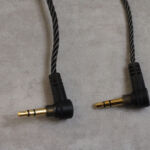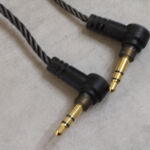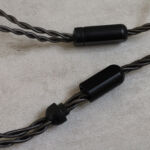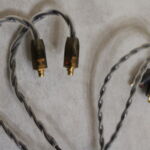Campfire Solaris 2020
9Disclaimer: I was sent the Andromeda 2020, the Solaris 2020, and the Ara as part of a review tour. I was not compensated for this in any way, nor did I get to keep any of the products reviewed. If you have an interest in Campfire products, please check out their website or facebook page.
Unboxing / Packaging:
We can skip this section as all three models arrived in their respective soft cases with the cable and earpieces inside each. Each also have a small two pocket bag that prevents the earpieces from rubbing together during storage to prevent scratches. Campfire has provided good cases for their iems since the outset and the latest models share that although it does make it tough to grab the one you want in a hurry as no labels exist to identify the model from the outside. Case color helps but in the short time I had the Campfire’s I didn’t memorize which color was which.
Build/Fit:
The Solaris is not the standard angular shell we are used to from campfire, but instead is kind of a rounded off rectangle the the rear and then rolls into a more rounded inner surface with the stainless nozzle protruding from the domed inner shell. Shells are aluminum with a PVD coating for added durability. PVD is a process rather than a material and is often referred to as thin-film coating and uses vaporized solids to coat surfaces evenly. The material used is not specified in this case but is a nice gloss black color that offsets the brass colored mmcx and vent and the bright stainless nozzle. The previously mentioned vent sits at top center immediately in front of the mmcx connector unlike a lot of current models that center the vent over the dynamic drivers face or rear. Fit wise, I found the smaller 2020 version quite a bit more comfortable than its predecessor and well worth another try if you found the original fatiguing (I did). I was able to wear the Solaris 2020 for several hours straight without discomfort which is not something I could say of its predecessor.
Internals:
Unlike a lot of Campfire’s line that is either dynamic (Atlas, Comet) or Balanced Armature (Andromeda, ARA, and others). The Solaris is a hybrid model with a 10mm dynamic driver handling bass and some of the midrange and 3 balanced armatures handling the remaining territory. The dynamic driver uses a diamond like carbon coated diaphragm similar to graphene and uses a vapor deposition process to evenly coat the entire surface of the diaphragm for improved uniformity. There is a single armature that handles the mids above the point the dynamic drops off and then a pair of armatures handling the upper frequencies. The Dynamic driver explains a good bit of the reason for the change in shape from the standard angular shell we have come to know Campfire for and also some of the reason for its larger size. The addition of the 3d printed guide that holds the components in alignment that is now standard in newer models is what allowed Campfire to shrink the 2020 model Solaris by nearly 25% without changing the driver configuration in order to do so. Nominal impedance is listed as 15.5Ω with a sensitivity of 91 dB/mW which puts the Solaris in a middle ground as its impedance is fairly low, but its sensitivity is a bit lower than the typical phone oriented in-ears. I found the Solaris worked from a phone or tablet but does scale quite a bit with better sources and definitely was happier with an amp added to my LG even in high power output mode.
Cable:
The Solaris2020 ships with Campfire’s Super Litz cable. At first glance it looks much like the same cable that ships with the ARA and Andromeda models, but closer examination reveals double the strand count and a heavier gauge. The Super Litz starts with a 90º 3.5mm jack with good strain relief before exiting as an 8 wire twist up to the splitter. The splitter is black aluminum with a matching chin slider (although it appears to be plastic). From the splitter up the two wire twists are a looser twist than the 4 wire below and terminate with ear-hooks and mmcx connectors marked R/L for reference. There is no red dot so one has to find the labels which are somewhat hidden. The cable is well made and avoids some of the common gimmicks while adding only the things that matter, good pliability, strain reliefs, and durability.
Below is a comparison of the Litz vs Super Litz cables with the Super on left (or bottom in the case of the splitters photo).
Sound:
Bass:
Having read all the specs on the Solaris and tried the original, I knew what to expect from the 2020 model. Bass has good extension and quantity, but quality is not quite up to par with other models in the Campfire line. Perhaps as a response to criticisms for using balanced armatures for bass, The Solaris uses a dynamic and trades some texture for quantity as a result. Decay is also slow enough to add some warmth which is atypical for Campfire’s all BA models as well, but again that slower decay also makes for a less feature rich landscape than things like Ara and Andromeda where quality is higher but quantity is quite a bit less. Mid-bass is a little better but still feels a bit smoothed over and is a bit less textured than I would like.
Mids:
Here again, the first thing I noticed is how much thicker the lower-mids are than other models in recent listening. In some ways this is a good thing. Singers like Joe Cocker really sound fantastic on the Solaris as it has adequate body and texture to really reproduce that vocal well and moves the vocal to the front of the instrumentation. For other more polished singers, the effect can be a bit more thickening than realistic and obstructs some details. Guitar growl is well re-produced if not quite as detailed as some. There is a fairly larger push forward as it moves into the true and upper-mids that pushes female vocals in front of their male counterparts by a full step. Violins have good energy due to this push, but can get harsh at higher volumes. I found the same to be true of female vocals as it is prone to fatigue and if a recording is sibilant, the Solaris does little to mitigate it.
Treble:
The lower treble drops back from the upper-mids with more emphasis in the true treble and 8-9kHz range. Extension is good with roll-off only above the limits of my hearing (roughly 14kHz) and there is enough air at top to keep the Solaris from feeling closed in. Snare rattle is good with sharp edges, and cymbals have enough energy to be near realistic although hi-hat can get a little clicky at times. Due to the 9kHz lift, I found the Solaris2020 a bit fatiguing for long sessions unless an EQ was applied to bring that range back down -3db, doing so does reduce the sparkle though so some will find it a poor trade off.
Soundstage / Imaging:
Stage has good dimensions with a little more depth than width and some height to the mix, although I didn’t find it to be class leading in this respect as it trails the Andromeda in overall dimensions. Seating the orchestra is fairly straight forward but again instrument separation is not as pronounced as with others in the line and the result is a more compact seating with some overlap. Layering is quite good in spite of the added thickness but imaging suffers a bit with sound positions particularly around center stage being more vague than I like like.
Comparisons:
Since they sent all three of the top models, it seems only fitting that I try and answer the “So which one should I get?” question that will come up for anyone perusing the Campfire website with cash in hand.
Both the Andromeda 2020 and Ara share the same shell albeit made of different materials (Aluminum vs Titanium) and both are slightly smaller and easier to fit in small ears as compared to the Solaris 2020. This is a much narrower gap than the 1st generation where the original Solaris was markedly larger and most will probably find that if one fits, the other will as well, but it is still worth mentioning that there is some size difference in the two body styles.
Both the Ara and Andromeda 2020 come with the same kit as the Solaris with the exception of the cable with the Solaris receiving the upgraded Super Litz version while the other two settle for the standard Litz. I prefer the Super Litz and would like to see Campfire adopt it as the standard for all models but until they do, purchasers of Andromeda and Ara models will have to purchase the super Litz as an added cost option.
Ara
The Ara uses a quartet of balanced armatures for bass and manages more slam than most all balanced armature models but still falls short of the Solaris in slam and rumble so those looking for bass quantity will prefer the Solaris. Those looking for the best bass detail may well prefer Ara as while it lacks a bit of impact compared to Solaris, it is a cleaner and slightly leaner presentation.
Mids are fairly linear on both the Ara and solaris but again Solaris has a bit more note weight and fluidity compared to Ara with a bit crisper more tightly defined notes. Neither is tuned in a way sibilance should be an issue so this will come to preference.
The lower-treble push on the Solaris stands in contrast to the slow climb from lower-treble into the true treble on Ara and give the Solaris a more splashy treble while the Ara maintains a bit more even keel.
Overall the Solaris is the more V-shaped delivery while the Ara is the more reference tuning. For many the Solaris may be more fun, but the Ara is likely the more accurate of the two.
Andromeda 2020:
The Solaris has more bass than the Andromeda, no question about it. If you are a basshead or have any tendency in that direction, the Solaris is the operative choice of the two here. The Andromeda has a cleaner low-end with very tightly defined notes and less note weight by comparison.
Mids are again less weighted but also cleaner on the Andromeda when compared to the Solaris that sounds richer and thicker but at the expense of a bit of detail in the process.
Treble’s here are more similar than the last pairing but the Solaris has more of a push in the lower-treble and comes out with a more V-shaped sound while the Andromeda stops short of it and has some extra energy that keeps it from being truly linear but less so than the Solaris. For me the Andro hits a happy medium and it will likely be a better option for the treble sensitive.
For two models that look more similar than not on paper these two have very distinct personalities with the Solaris 2020 feeling, smooth, fluid, and effortless while the Andromeda feels like a relentless detail monster.
Thoughts / Conclusion:
Well if you read through this far, you are probably expecting me to say that I am not a big fan, and that is partially correct. I do think that there is a lot of coloration to the Solaris that isn’t going to be for everyone, but I also think it may be the most forgiving and musical Campfire I’ve tried to date. Sure it trades a bit of detail for smoothing some rough edges and no it is definitely not a reference tuning, but when listening casually for enjoyment, none of that really matters. Add to that a few Mp3s of questionable pedigree, a few tracks that were poorly mastered to begin with, and the other maladies most of our music collections are plagued with, and the Solaris can be a much more pleasing listen than something like the Andromeda that puts every blemish on full display. What the Solaris lacks in technical perfection, it makes up for in engagement and just plain enjoyment. Those looking for reference perfection should probably look to another model in Campfire’s lineup, but those looking for the most musical and just plain fun listen can probably stop at the Solaris 2020.
-
Bass - 7.5/107.5/10
-
Mids - 7.5/107.5/10
-
Treble - 7.5/107.5/10
-
Soundstage - 8/108/10
-
Imaging - 8/108/10
Summary
Pros: Solid build, more reasonable size, good end to end extension, warm coloration, good stage
Cons: Maybe too much coloration, Still a fairly large in-ear, tuning not for everyone























